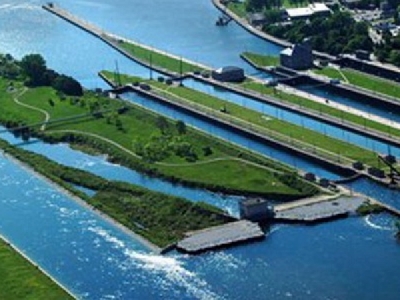
Posted on July 12, 2016
By Garret Ellison, MLive Media Group
Michigan Gov. Rick Snyder is lobbying Congress to fund a reconstruction project at the aging Soo Locks complex in the Upper Peninsula.
On Tuesday, July 5, Snyder sent a letter to Michigan’s 14 representatives and two senators advocating full funding for a long-stalled replacement of two smaller locks with a new single lock big enough to handle the largest Great Lakes ships.
Twinning the 1,200-foot Poe Lock would create redundancy at the shipping complex on the St. Mary’s River, a bottleneck in the domestic iron ore supply chain. Because of its size, the Poe Lock is the only one of four locks in Sault Ste. Marie big enough to handle 1,000-foot ships, which carry 70 percent of all Great Lakes cargo.
Congress authorized the reconstruction project in 1986, but the work has languished due to a lack of funding.
A recent Department of Homeland Security report predicted an unscheduled six-month outage of the Poe Lock would cripple the U.S. economy, cost 11 million jobs and shut down almost all North American appliance, automobile, construction, farm and mining equipment, and railcar production within weeks.
A six-month outage could increase unemployment by 18 to 22 percent in the Great Lakes region, according to the report. On the flip side, Snyder said building a new lock would generate 15,000 jobs in the eastern U.P.
The lock outage problem was underscored last summer when the smaller MacArthur Lock unexpectedly broke down for 20 days in the middle of the shipping season. While that didn’t bring shipping to a halt, it did cause backups, jumble port schedules and cause widespread worry.
“The longer we delay on preemptive measures to mitigate lock closures, the more real a complete shutdown of Great Lakes steel production becomes,” Snyder wrote.
Previous estimates have pegged the project at $580 million. Congress gave the U.S. Army Corps of Engineers about $18 million in 2009 to start construction, but that’s only been used to install cofferdams and dredge the river channel.
Last year, the Army Corp got $1.35 million to re-do an economic study on twinning the Poe, which freighter companies say will replace a flawed 2005 cost-benefit analysis that rendered the project ineligible under federal budgeting because it showed every dollar spent would only return 73 cents in benefit.
The Lake Carriers Association says that old analysis erroneously assumes iron ore, coal, grain and other cargos passing through the locks could instead be moved by railroad or commercial trucks. However, the DHS report says those industries don’t have the transportation capacity and Great Lakes steel mills and power plants aren’t set-up to receive cargo that way.
Although plans for twinning the Poe have been on the books for years, the Army Corps has relied on annual appropriations to address maintenance and upkeep. This summer, the locks are getting a new computerized master control system to keep pace with the technology on ships that pass through.
“As we continue to address infrastructure needs across the state, the Soo Locks must be a priority,” Snyder said, in a statement. “Only by mitigating these risks now can we ensure future public safety and economic stability.”
Snyder called for the new lock in his January State of the State address. In June, he and Ontario Premier Kathleen Wynne called for a regional strategy to double maritime trade by rebuilding the Soo Locks, dredging the St. Mary’s River and streamlining customs clearance for international passengers and cargo.
Snyder is preaching to the choir by lobbying Michigan’s Congressional delegates, who have been separately advocating Soo project funding in Washington.
In May, Sen. Gary Peters, D-Michigan, toured the locks. Afterward, he pledged to continue efforts to ensure the locks received “necessary funding.”
“The Soo Locks are the lifeblood of economic activity on the Great Lakes, with many Michigan businesses relying on the Soo Locks to help transport their products to markets across America,” said Peters, a member of the homeland security and governmental affairs committee and Great Lakes task force.
Peters and Sen. Debbie Stabenow, D-Michigan, lobbied the U.S. Army Corps this year to expedite the economic study, asking that “every effort be made to compete this analysis as quickly as possible.” Were construction to begin immediately, the rebuild project could take a decade to finish.
Source: mLIVE





